Making Maritime Heritage: Grassroots Engagements in Bagamoyo, Tanzania
All around the Indian Ocean littoral, coastal communities and those in the hinterlands find themselves at odds with official heritage narrations of the sea. Among the Arab Gulf states, for example, treatments of pearling and seafaring by big-budget museums erase communal diversities for the sake of unifying national mythologies. In India, just as the country’s first national maritime museum is planned, Hindutva nationalism promotes a maritime heritage expressing a heroic and exclusively Hindu naval past. Meanwhile, in Sri Lanka, coastal Tamil, Muslim, and Christian communities find themselves not only excluded from the government’s Sinhala-Buddhist heritage-making, but sometimes also fearing eviction through the politicised use of archaeological designations. Can we – maritime archaeologists and heritage professionals with limited resources – find approaches that resist such top-down forms of heritage-making and serve the needs of local communities? In the Tanzanian coastal town of Bagamoyo, official heritage narratives are not so much hostile to the needs of the local community as tone-deaf to them.
In Bagamoyo, a nineteenth-century town of artisanal fishing people and traditional boatbuilders, official heritage designations centre very much on built structures – chiefly the many buildings in the central Conservation Area and, a little outside of town, the ruins at the Kaole Ruins archaeological site. This monument-based approach is a direct legacy of colonialism, with British imperial legislation persisting largely unchanged into the independence era. One result of this situation is that officially designated “heritage” mainly comprises buildings, such as the Customs House, the Old Post Office, and, on the outskirts of town, the Roman Catholic Church. Among these are monuments with deeply painful associations for local people: the Boma administrative building and the Old Fort are reminders of the brutalities of German and British imperialism, while the nearby caravanserai recalls the depredations of the Indian Ocean trade in enslaved people, as well as ivory.
Tensions are also evident at ostensibly more “neutral” archaeological sites, such as Kaole Ruins, the thirteenth-fifteenth-century Swahili site that lies some 5km down the coast from Bagamoyo. Here legal designations have placed barriers – literally – between local people and the site, hampering traditional relationships, including pilgrimage and other related ritual activities at the mosque on the site and its surrounding landscape. Unhappiness with existing policies among local people in the neighbouring village of Kaole has led to a conflictual relationship with the site’s management, with residents periodically closing the road taking tourists to the site. Villagers have also communicated their discontent to the National Assembly through their Bagamoyo constituency representatives decrying how the government treats them in relation to the management of the site and the distribution of benefits from it.
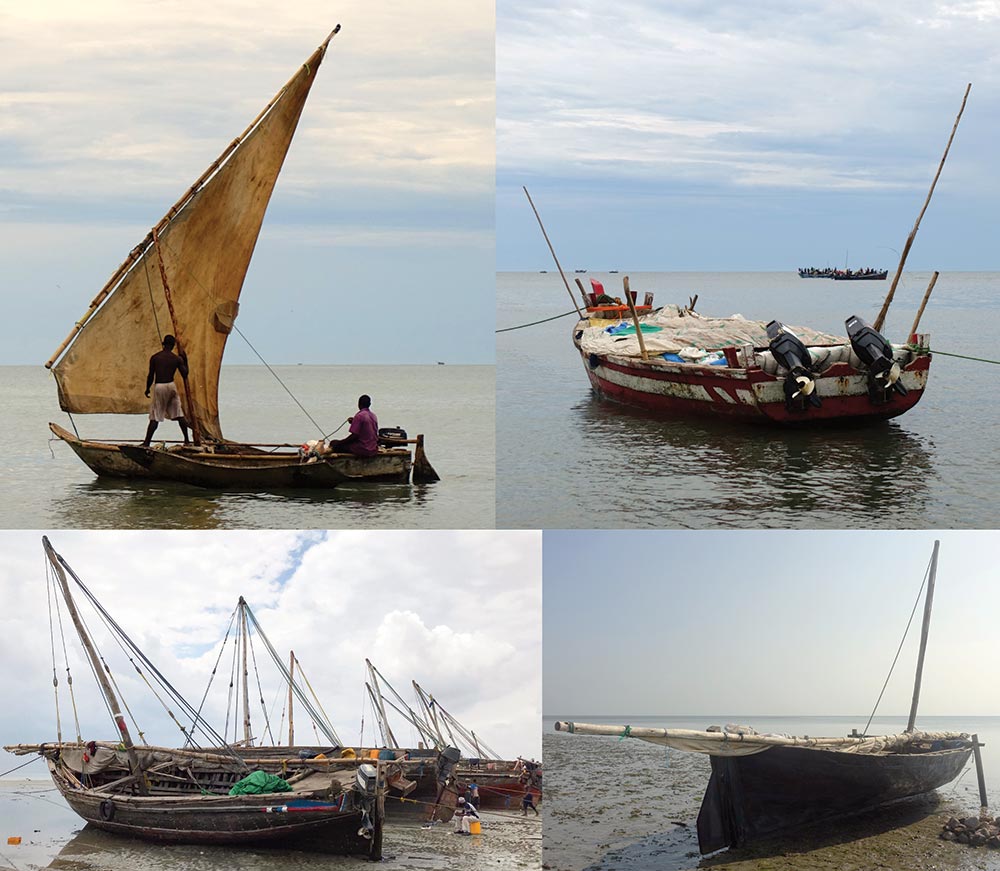
Fig. 2: Bagamoyo’s nautical heritage (clockwise): ngalawa fishing dugout under sail; the motorised mtando; mashua cargo vessels; a rare mchoro. (Photos courtesy of Bahari Yetu Urithi Wetu Project, 2019-2020)
In sharp contrast, the day-to-day breadwinning activities of people in Bagamoyo represent a wealth of maritime material culture and intangible heritage that operates entirely outside the purview of official heritage narratives and policy. The fishing and cargo-trading fleet alone represents a wealth of traditional wood-based boatbuilding and boat carving that few places around the Indian Ocean can today match. Unlike countries such as Sri Lanka and most of the Arabian Peninsula, fibreglass watercraft are few and far between. The artisanal fishing fleet includes four varieties of wooden log-boat, including the ubiquitous double-outrigger ngalawa, as well as several varieties of plank-built vessel, from the increasingly rare double-ended mchoro to the newly innovated ngwanda and mtando. Relatively large plank-built cargo vessels such as the mashua also operate out of Bagamoyo, plying back and forth to the islands of the Zanzibar Archipelago. What is more, the great majority of these vessels rely on the sail, a propulsion technology that has entirely disappeared from much of the Indian Ocean periphery. But here, too, outboard motors are making inroads: the gradual disappearance of the mchoro reflects demand for hulls with transom sterns that can take motors; the newcomer ngwanda and mtando only use motors; and the larger mashua cargo craft alternate between motor and sail to optimise speed and costs in their crossings of the Zanzibar Channel.
Although immediately striking to the outside visitor, the watercraft of Bagamoyo are but one aspect of the town’s maritime story. Underpinning their existence are a cohort of skilled carpenters and carvers whose technical knowledge and craft skills rest only within the mind-body complex of each practitioner. It is through them that the tradition and innovation in the wooden boat-building industry apparent in the Bagamoyo fleet are realised. Once built, the boats of Bagamoyo enable new forms of traditional and intangible knowledge – of seascapes and landmarks, of fishing grounds and weather, of sea states and season, of the behaviours of fish and the methods of catching.
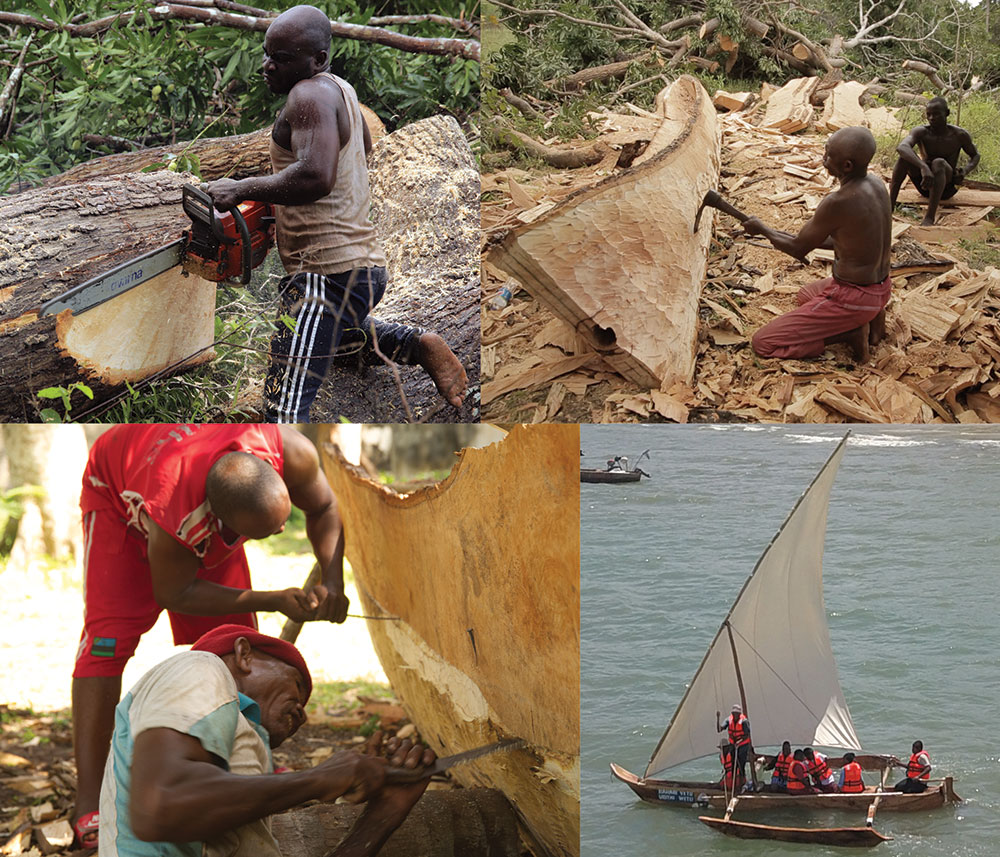
Fig. 3: Mzee Alalae builds a ngalawa: rough-shaping the mango tree; shaping the hull with an adze; attaching an extension plank; the finished vessel under sail. (Photos courtesy of Bahari Yetu Urithi Wetu Project, 2021)
Activity at sea is mirrored in activity on land, extending the maritime cultural landscape ashore. Bagamoyo’s waterfront is shaped by conventional practice: the beach is where the catch is landed, traded, and descaled; above the high-water mark, operating boats are stored and repaired, and new ones are built. Outside the colonial-era Customs House, porters load mainly timber and poles to the mashua for shipping to Zanzibar. At the same time, other porters unload canisters of cooking oil and other cargo from other mashua on the return journey. Along the waterfront, fish are cooked or loaded into trucks heading to consumers in Dar es Salaam and regions inland. Sardines are dried, nets laid out and repaired.
In the mangroves near Kaole Ruins, women gather fresh mangrove whelks which they use to prepare stew that they sell to tourists or ship home for domestic use. Elsewhere, men sit under baobab and other majestic trees making new madema (fish traps) and repair old ones, while telling stories about the sea and what it offers. Some 2.5km north of Bagamoyo, coastal salt pans that have been operational for centuries continue to operate in the traditional manner. In the nearby streets and villages inland such as Kaole, Magomeni, Dunda, and Nianjema, one sees multiple houses with and surrounded by maritime paraphernalia: small boats, their masts and oars, fish traps and nets, and suchlike. Some houses have on their wall or doors colourful pictures and images that tell of people’s relationships with the sea, such as boats, the coastal environment, and fish. Some streets have wooden signs that have been carved with similar maritime imagery. In one street, there are groups of men whose daily activity is to traditionally melt and weld metal to produce the nails used in the boats that are made along the shoreline.
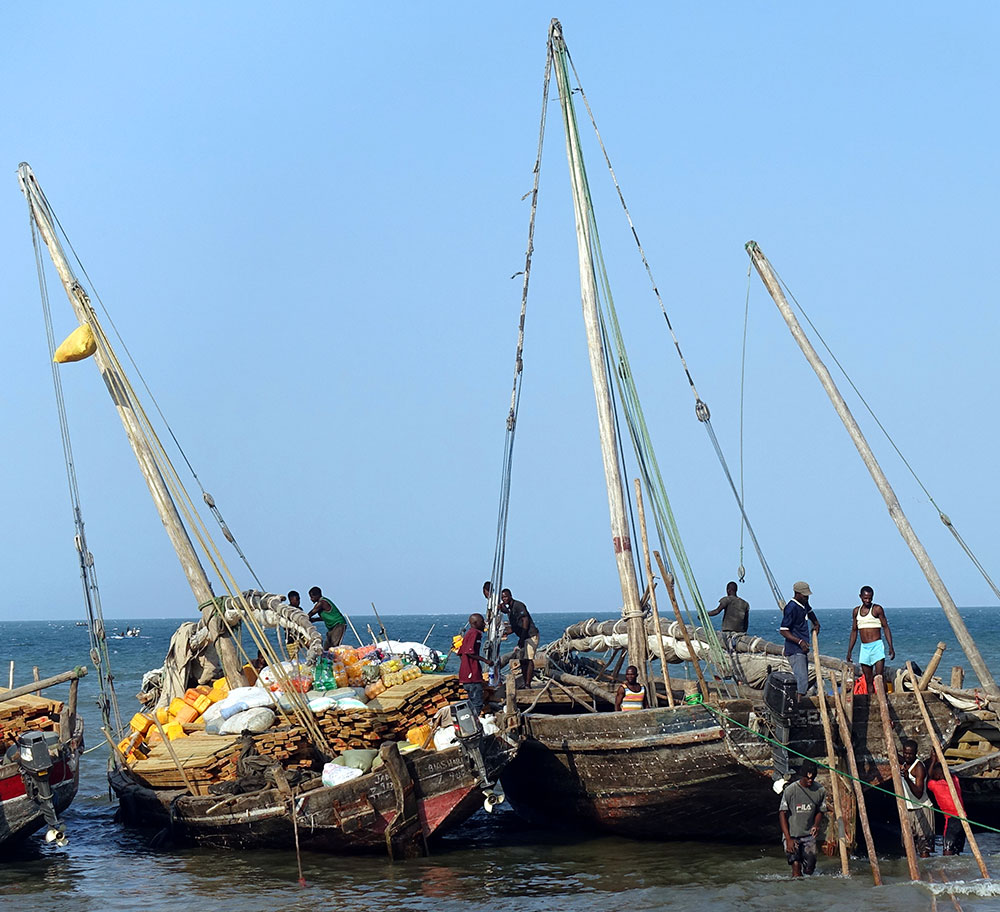
Fig. 4: Mashua cargo vessels wait for the rising tide to sail for Zanzibar. (Photo courtesy of Bahari Yetu Urithi Wetu Project, 2019)
To an outsider with no direct stake or interest in maritime heritage, Bagamoyo appears as something of a wonderland—part living museum, part repository of forms of artisanal knowledge that have vanished elsewhere. But not so for the practitioners themselves. Challenging for us, as heritage practitioners seeking out engaging manifestations of cultural practice, people we polled told us that their most valued heritage was not a particular object or practice, but rather “the sea.” Meanwhile, the state not only fails to recognise this maritime heritage – however it is conceived – but it also criminalises much of it through fisheries legislation, leading to periodic crackdowns and boat-burnings.
Running from 2019-2021, our Bahari Yetu, Urithi Wetu (Our Ocean, Our Heritage) project sought to explore the notion and utility of the maritime heritage concept through direct engagement with the Bagamoyo community. In many ways, our approach was ethnographically conventional: we met and interviewed people; we mapped the maritime cultural landscape; we documented and typologised material culture, particularly the watercraft. But our activities also took unexpected turns: a co-creative workshop at the beginning of our fieldwork gained us advocates who stayed with us throughout the project. A co-created community exhibition of material culture, historic photographs, and project-generated photography and video was, pleasingly, attended by more than 500 people including pupils from local schools. But what brought it alive was the way boatbuilders and fishers themselves stepped forward to showcase and interpret their boats and fishing gear to visitors. Meanwhile, the talents of University of Dar es Salaam (UDSM) students afforded new means of promoting awareness. A music video featuring student Claudia Lubao (a.k.a. Chemical), alongside artists Innocent Omary (a.k.a. Centano) and Salum Bavuga (a.k.a. Honest), raised important issues through the popular Bongo Flava music genre. And a chance encounter with self-taught boat carver Mzee Alalae gave rise to a Swahili-language documentary film, made by our team members, that recorded his construction of a ngalawa. Finally, we supported local boatbuilders in establishing a professional boatbuilding association, CHAMABOMA-Bagamoyo, which facilitates collaboration between builders, represents their interests, and promotes training opportunities for youngsters. As a male-only enterprise, CHAMABOA-Bagamoyo was an important addition to the WAUTO-Kaole women-only enterprise that UDSM and collaborator, the Escalla Initiative, established in 2017 to support participation in coastal heritage protection alongside income-generating businesses. This gender symmetry acknowledges that both men and women can participate in the protection and preservation of coastal marine heritage while also earning income to improve their livelihoods.
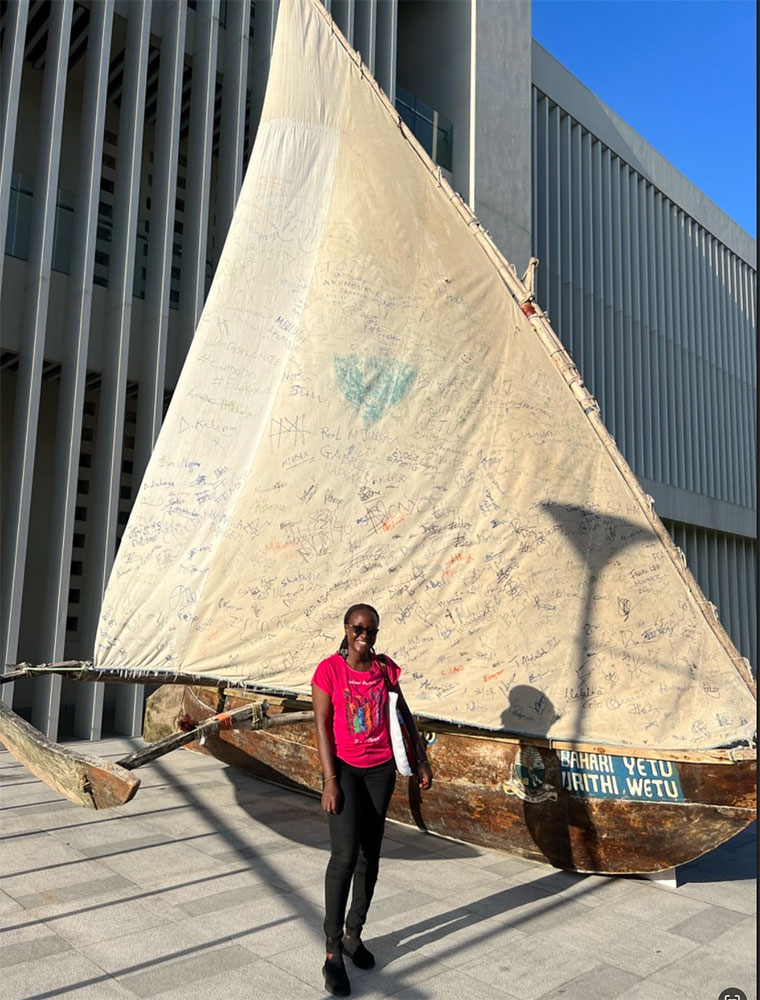
Fig. 5: The Bahari Yetu Urithi Wetu ngalawa with its sail signed by some of the exhibition visitors at the University of Dar es Salaam ICHU: the signed sail. (Photo courtesy of Bahari Yetu Urithi Wetu Project, 2021)
Bahari Yetu, Urithi Wetu closed with a forum held on the UDSM campus that brought members of the Bagamoyo maritime community, policymakers, and academics face-to-face with representatives of various ocean-facing government agencies overseeing museums, antiquities, tourism, marine parks, fisheries, and forestry, as well as the Tanzanian National Commission for UNESCO. Alongside the forum, a UDSM Maritime Week recreated the Bagamoyo community exhibition, showed the documentary film, and engaged with national media. The project ngalawa, built by Mzee Alalae, was shipped from Bagamoyo to UDSM for the duration. It became a centre of attraction when visitors were given the opportunity to sign the sail and so historicise their appreciation of the craftsmanship.
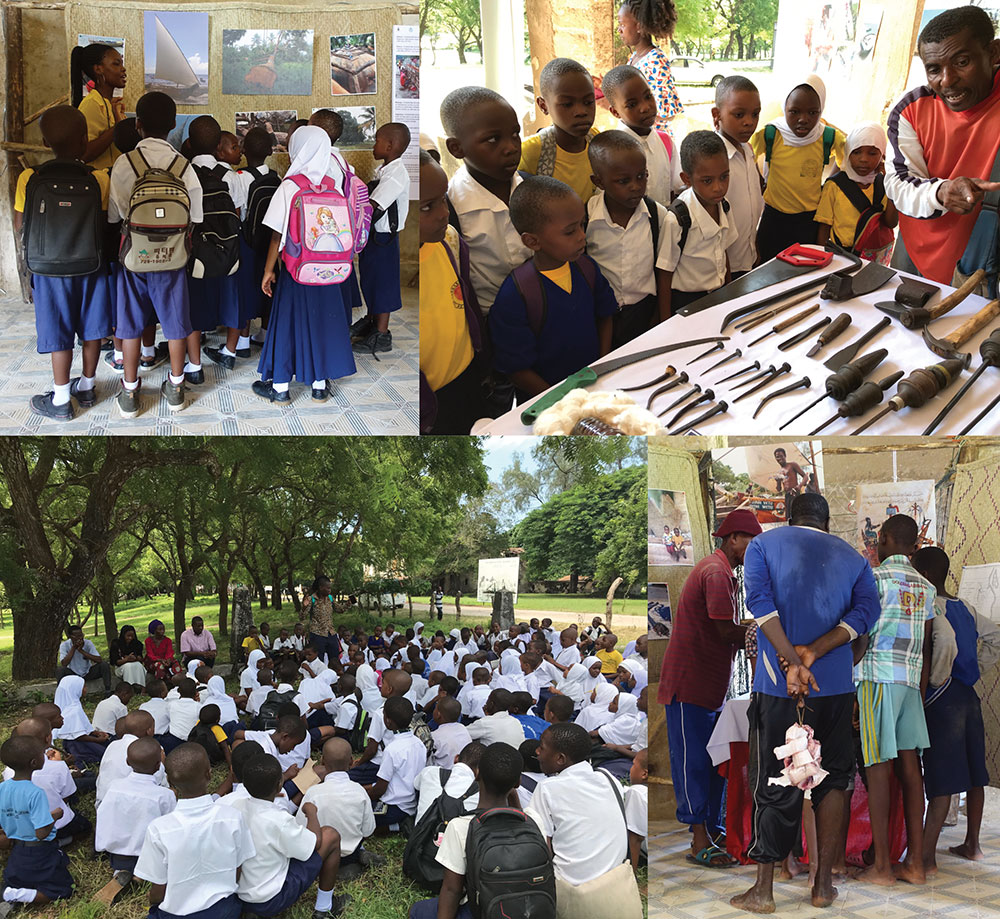
Fig. 6: Scenes from the 2020 Bahari Yetu, Urithi Wetu exhibition at the Boma building in Bagamoyo. (Photos courtesy of Bahari Yetu Urithi Wetu Project, 2020)
No matter how ambitious, a small project such as ours could not expect, on its own, to transform Tanzania’s national maritime-heritage priorities to better reflect the perspectives of sea-facing communities such as Bagamoyo’s. But it could – and did – celebrate their skills and livelihoods through ephemeral exhibitions, enduring digital media, and conventional academic publication. Time will tell whether these efforts contribute to a national reconceptualization of heritage and its protection. In the meantime, we take heart from the comment of one of our boatbuilder colleagues: “Since we took part in this project, people look at us differently. Before they barely noticed us on the beach. Now, we feel pride in what we do.” And, as one visitor to the exhibition said: “The University of Dar es Salaam and its collaborators have shown us what conducting research for and with the community means. Visiting the exhibition, listening to the students’ narrations about what you have achieved, and learning how to use different tools to make boats from the boat builders themselves is fantastic. Professors, students and the local people learning from each other and producing such an exhibition for us has been extremely wonderful.”

Fig. 7: Bagamoyo’s built – and problematic – heritage (clockwise): the Boma; the Old Fort; the principal mosque at Kaole; the Caravanserai. (Photos courtesy of Bahari Yetu Urithi Wetu Project, 2019-2020)
Based on our experience during and after implementation of this project as well as the comments from hundreds of people who learned about the maritime heritage of Bagamoyo, a central question, “what next?” remains. What happens next is a question not only for us and our collaborators, but for everyone interested in maritime heritage and wishing to see coastal communities in the Indian Ocean World continue to celebrate their heritage while sustainably maintaining the livelihood opportunities offered by the sea. We therefore invite stakeholders interested in either collaborating or supporting our initiatives in Bagamoyo and elsewhere in the Indian Ocean World to reach out and engage. It will be through such collaborative efforts that initiatives to preserve maritime heritage thrive alongside sustainable livelihood options among coastal communities in Tanzania and beyond.
John P. Cooper is Associate Professor of maritime archaeology and Arabic at the University of Exeter, UK. Email: J.P.Cooper@exeter.ac.uk
Elgidius B. Ichumbaki is Associate Professor of heritage studies at UDSM in Tanzania, visiting Associate Professor in the School of Archaeology at the University College Dublin, Ireland, and Adjunct Professor in the Division of Cultural Heritage Convergence, Korea University, South Korea. Email: Ichumbaki@udsm.ac.tz